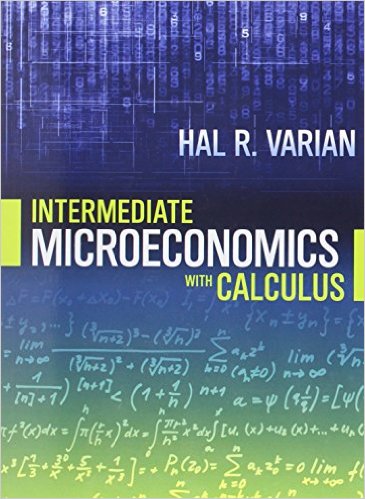- Paperback: 832 pages
- Publisher: W. W. Norton & Company; 1 edition (April 7, 2014)
- Language: English
- ISBN-10: 0393123987
- ISBN-13: 978-0393123982
- Product Dimensions: 6.8 x 1.2 x 9.3 inches
范里安:使用微积分的中级微观经济学 (2014年第一版)

文件大小:未知
级别评定:★★★★★
添加时间:2015-10-13 13:37:54
最后更新:2015-10-13 13:51:32
下载积分:0分 (只有会员文件下载时才需要相应积分验证)
总浏览:
总下载:455
发布人:george15135
- 如果您发现该资源不能下载,请在本站论坛提出,管理员会及时处理。
- 未经本站明确许可,任何网站不得非法盗链及抄袭本站资源。
- 本站资源均为网友提供交流,仅供教学、研究使用,请下载后24小时内自行删除。
资源简介
Intermediate Microeconomics with Calculus: A Modern Approach 1st Edition
Editorial Reviews
About the Author
Hal R. Varian is the chief economist at Google.
Product Details |
如下内容摘自范里安本书的前言,说明了撰写该书的初衷及该书的特色:
This book is my classic Intermediate Microeconomics text with the Mathematical treatment that was previously in the chapter appendices incorporated
into the body of the chapters. This makes the analysis flow somewhat better for those students who are comfortable with elementary calculus.
My aim in writing the original text was to present a treatment of the methods of microeconomics that would allow students to apply these tools on their own and not just passively absorb the predigested cases described in the text. I have found that the best way to do this is to emphasize the fundamental conceptual foundations of microeconomics and to provide concrete examples of their application rather than to attempt to provide an encyclopedia of terminology and anecdote.
The calculus treatment will, I hope, be helpful to students who have appropriate backgrounds. However, it should be remembered that one can go a long way with a few simple facts about linear demand functions and supply functions and some elementary algebra. It is perfectly possible to be analytical without being excessively mathematical.
The distinction is worth emphasizing. An analytical approach to economics is one that uses rigorous, logical reasoning. This does not necessarily require the use of advanced mathematical methods. The language of mathematics certainly helps to ensure a rigorous analysis and using it is undoubtedly the best way to proceed when possible, but it may not be appropriate for all students. This is why there are two versions of the text.
Calculus offers deeper ways to examine the same issues that one can also explore verbally and graphically. Many arguments are much simpler with a little mathematics, and all economics students should learn that. In manycases I’ve found that with a little motivation, and a few nice economic examples, students become quite enthusiastic about looking at things from an analytic perspective.
There are several other innovations in this text. First, the chapters are generally very short. I’ve tried to make most of them roughly “lecture size,” so that they can be read in one sitting. I have followed the standard order of discussing first consumer theory and then producer theory, but I’ve spent a bit more time on consumer theory than is normally the case.
This is not because I think that consumer theory is necessarily the most important part of microeconomics; rather, I have found that this is the material that students find the most mysterious, so I wanted to provide a more detailed treatment of it.
Second, I’ve tried to put in a lot of examples of how to use the theories described here. In most books, students look at a lot of diagrams of shifting curves, but they don’t see much algebra, or much calculation of any sort for that matter. But it is the algebra that is used to solve problems in practice.Graphs can provide insight, but the real power of economic analysis comes in calculating quantitative answers to economic problems. Every economics student should be able to translate an economic story into an equation or a numerical example, but all too often the development of this skill is neglected. For this reason I have also provided a workbook that I feel is an integral accompaniment to this book. The workbook was written with my colleague Theodore Bergstrom, and we have put a lot of effort into
generating interesting and instructive problems. We think that it provides an important aid to the student of microeconomics.
Third, I believe that the treatment of the topics in this book is more accurate than is usually the case in intermediate micro texts. It is true that I’ve sometimes chosen special cases to analyze when the general case is too difficult, but I’ve tried to be honest about that when I did it. In general, I’ve tried to spell out every step of each argument in detail. I believe that the discussion I’ve provided is not only more complete and more accurate than usual, but this attention to detail also makes the arguments easier to understand than the loose discussion presented in many other
books.
